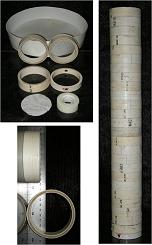American Society of Agronomy
5585 Guilford Road • Madison, WI 53711-5801 • 608-273-8080 • Fax 608-273-2021
www.agronomy.org
Twitter | Facebook
5585 Guilford Road • Madison, WI 53711-5801 • 608-273-8080 • Fax 608-273-2021
www.agronomy.org
Twitter | Facebook
NEWS RELEASE
Contact: Hanna Jeske, Associate Director of Marketing and Brand Strategy, 608-268-3972, hjeske@sciencesocieties.org
Students Get a Feel for Soil-Water Relationships
 MADISON, WI, August 2nd, 2010 - Using little more than PVC rings, a trashcan, and a scale, students can literally get a feel for soil water retention and field capacity, concepts that are important and useful in fields from farming to engineering.
MADISON, WI, August 2nd, 2010 - Using little more than PVC rings, a trashcan, and a scale, students can literally get a feel for soil water retention and field capacity, concepts that are important and useful in fields from farming to engineering.
The demonstration, developed by Adam Howard, Drs. Josh Heitman and Dan Bowman of North Carolina State University, was designed to illustrate concepts that can be difficult for students to visualize and understand, and the equipment for making measurements of these variables is expensive. They report their method in the 2010 Journal of Natural Resources and Life Sciences Education, published by the American Society of Agronomy, the Crop Science Society of America, and the Soil Science Society of America.
The demonstration begins by taping short rings of PVC pipe together into a tall column. That column is then filled with soil and placed in a trashcan, and filling the trashcan with water to saturate the soil column. Saturating the column represents a long, soaking rainfall event.
The column is then removed from the trashcan, and allowed to drain for a day or two. When the excess water in the soil is drained away, the water left is the water contained in the soil at field capacity. Then the rings of the column are separated and the soil in each ring is weighed. As the column is sectioned from the top to the bottom, students are able to feel the differences in the soil water content. The soil is then dried and weighed again to determine the water content in each ring.
The concept of field capacity is one that arises often in soil, crop, and horticultural science disciplines. Field capacity is generally defined as the water content of a soil after free water no longer drains from a thoroughly wetted soil.
Field capacity is generally reported as a single number, which would be the average of the water contents in the rings, but few who use this information know where that number originated. Nor do they realize that this there isn’t one value throughout the depth of the soil, but a continuum of water concentration that increases as you move from the top of the column towards the bottom.
A number of factors influence this soil water content continuum, including the soil texture, or the size of the soil particles, structure, or the way those particles are arranged, and depth to the water table.
The water retention relationship is a valuable tool in many disciplines. This is a relationship that connects the energy status of soil water to the soil water content. The soil water energy status, or potential, is the driver behind water movement in soils. Potential is also what plant roots must overcome to extract water from the soil. Plants wilt at very negative potentials, because they can no longer overcome the tension in very dry soils that limit water movement.
Through this very simple and inexpensive demonstration, students are better able to understand the soil, water, and plant relationships that surround us every day.